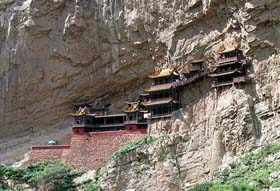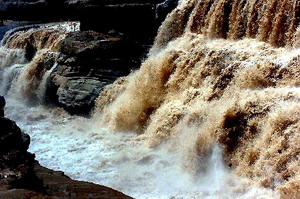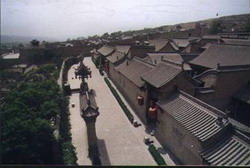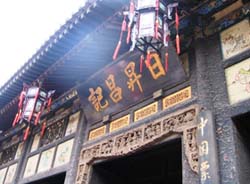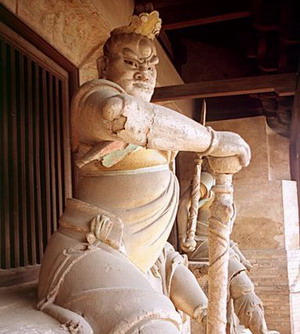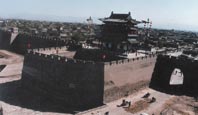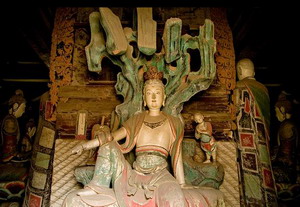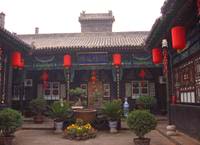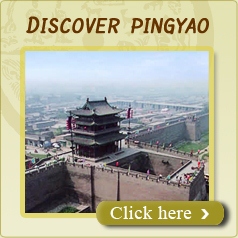Pingyao Tourism
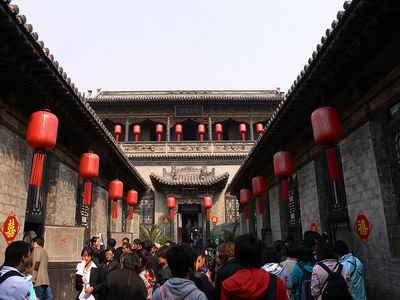
-
City Name:Pingyao (Chinese: 平遥, Pinyin: pingyao)
-
Population :490,000
-
Area :1,260 square km (486.5 sq mile)
-
Overview:Pingyao is a small city in the southwestern edge of Shanxi Province. It still retains its city layout from the Ming and Qing dynasties.
Overview
The past is alive in Pingyao. Whereas other cities have embraced modernity often at the expense of their historical heritage, Pingyao tenaciously holds onto its past.
As dawn breaks and the morning sun bathes Pingyao's gray city walls in warm tones, you find yourself flung back in time, as your eyes behold a Ming dynasty fortress in all its imposing glory. Watchtowers, cast iron cannons, intimidating wooden gates and sturdy walls render an impenetrable feel. And then the city wakes up. Narrow alleys that coil around time-honored couryard homes fill up with its 480,000 denizens. Shops open their doors to reveal modern cashier equipment perched on antique tabletops. Bustling about are bicycles, rickshaws and scooters. Here in Pingyao, modernity lives with centuries old relics.
The old walled city is an architectural treasure trove. Civic buildings, private homes and streets are well preserved in Ming and Qing styles. Several are aborned with splendid eave roofs, intricately latticed windows, hand-painted glass lanterns and ornate wood. Such exquisite handiwork didn't come cheap, but then again, Pingyao was China's premier banking center during the two dynasties. Its wealty residents were comprised of merchants and businessmen who set about constructing sprawling mansions as expertly as they built up their business and trade. Of the many banks in Pingyao, Rishengchang Exchange Shop is the most famous. Orginally established in 1643, it still has records of its earliest days in business.
Know More
One reason for the city's prosperity was its location. It lay at the heart of Shanxi Province between the central plain and the northern desert. Han Chinese merchants occupying the central plains could communicate easily with the northern tribes and set up trade links with the rest of China.
The stoic city walls also did its part to shield Pingyao from marauding enemies from the 14th to 19th centuries, allowing the city to flourish swiftly. The walls were first erected in the Zhou dynasty and last rebuilt during the Ming. After the Song army set the earthen walls on fire in A.D 960, the walls were covered with bricks.
The fortifications are sophisticated-the square perimeter is 12m high and 5m thick and there are platforms every 50m with 3,000 crenels on the outer wall, 72 watchtowers, and a water drainage system reinfored with bricks at the top. The wall is surrounded by moats 3m wide and deep and six suspension bridges once fronted each city gate. Walking all the way around the walls may take you 2 hours.
By the 19th century, the once dynamic town fell into provincial obscurity and the walls became a psychological prison. When modernization fever swept through China in the 1980's, town officials laid plans to demolish the ancient city and rebuild the town to accommodate what was hoped to be a future economic boom.
As the city planners dreamt of a modernized cuty and Pingyao's economic revival, people on the ground struggled to rescue the ancient city. Professor Ruan Yisan, who specialized in urban planning at Tongji University in Shanghai, worked tirelessly to make officials aware of the culture value of Pingyao. His efforts paid off, and modernization was left outside the ancient wall. In 1986, Pingyao was declared a national historical city and protected it from demolishing. The town was flushed with funds, accelerating its conservation efforts. In 1997, Pingyao made it to the list of UNESCO's Wold Heritage Sites, thus a silver lining finally revealed itself.
Must see
Inside Pingyao
Slipping into the city, you feel as if you're entering the movie set of an elaborate Chinese period drama production. Elegant Ming and Qing architecture line the quaint steets.
- Mingqing Street
- Town Tower
- Tongxinggong Armed Escort Company Museum
- Temple of the City God
- Rishengchang Draft Bank
- Qiao Family Courtyard Compound
- Wang Family Courtyard Compound
- Shuanglin Temple and Zhengguo Temple
The street also known as Nan Da Jie, the main downtown thoroughfare. This street has undergone major restoration and its attractions now include hotels offering traditional brick -oven beds restaurants serving Pingyao's famous beef and shops hawking an astonishing array of art warens such as antiques, furniture, ancient coins, Chinese paintings, jadeware, lacquerware and traditional folk clothing.
On Mingqing Street, just shouting to be climed, is the 18.5m high Town Tower. Don't start your ascent without your camera: catching the view of inundating tiled roofs of the entire city when you reach the top, listening to the sounds of the city below, this can be a memorable experience.
You can find many notable museums along Mingqing Street. For example, Tongxinggong Armed Escort Company Museum, it offers an eye-opening insight into the significant role played by armed escorts in promoting commerce. The economic boom under the two dynasties meant a lot of cash moving from one area to the next. To thwart thieving hands, Pingyao's ever-resourceful and pragmatic merchants lete their cash cows in the professional hands of security escorts.
The Temle of the City God on Mingqing Street hails from the Northern Song dynasty. Visitors enter through a double-eave, triple-gate wooden archway. It has a theater hall, where one can catch operatic shows during the annual temple fair on May 27, with six large urns positioned to amplify the performer's voices.
On the eastern end of Xi Da Jie si Rishengchang, meaning "sunrise prosperity," China's first bank. What started our as a single businessman's efforts to sately manage the accounts of his widely spread company, became a private banking enterprise that caught on like wildfire-similar phenomenon occurred in Europe at the end of the Middle Ages. Now converted into a museum, the head office was on this same site during the Qing dynasty.
Outside Pingyao
Northern Chinese architecture here is excellently preserved, and "Locals in Pingyao comprise mainly Han Chinese whose families have lived here for a few generation, people here have sunk long root. They love their homes. " You'll get this expression when stepping into the Qiao Family Courtyard House and the Wang Family Courtyard House.
The Qiao Family Courtyard House was the home of a powerful trading family with significant commercial influence even beyond Shanxi, as they were in the trade sector, a nationwide business. It was in this mansion that award-winning Chinese director Zhang Yimou set interior scenes for his film Raise the Red Lantern. Located some 20km north of Pingyao, the compound is fortified behind a 10m high wall with battlements. With 313 rooms, you'll see many examples of typical northern Chinese architecture here.
The Wang Family Courtyard House was the Wang clan's private residence and is four times large than Qiao's, with 54 courtyards and 1,052 rooms.The mansion took more than half a century to build and is located on a hilly area. This rambling complex was home to the first Wang family in 1312. The wangs has a rages-to-riches story, starting out as farmers and bean curd sellers, before entering business and politics. Some 300 family members later became officials.
Shuanglin Temple, a musty monastery 7km south of Pingyao, has traditional paintings and some 2,000 terracotta figurines dating back to the Song and yuan dynasties. Other temples include Zhengguo Temple 15km north of Pingyao, which features Buddha figures and Dacheng Hall, located southeast of Pingyao. It's the only Confucian temple built during the Song dynasty and has an 800-year history. They both are the World Cultural Heritage.
